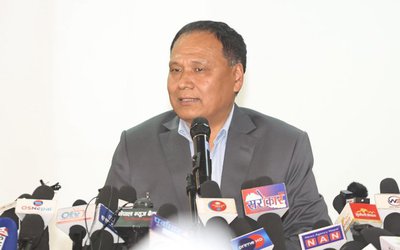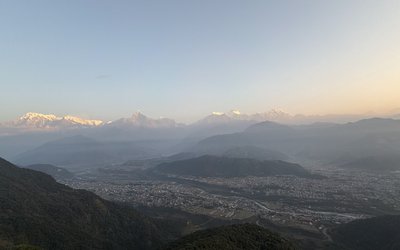
Nepal's energy sector is undergoing a rapid shift towards green hydropower as a replacement for fossil fuels. The recent commitment from senior officials of the World Bank and the Asian Development Bank to fund the Upper Arun and Dhudh Koshi storage project is highly significance.
Following a survey of the project sites in remote eastern Nepal, the World Bank has a strong determination to begin development of the 1,061 MW Upper Arun semi-reservoir hydroelectric scheme. The project will be located in the Bhotkhola Rural Municipality of Sankhuwasabha.
At a high-level meeting, progress was discussed among attendees including Dr. Prakasharan Mahat, Minister of Finance, Shakti Bahadur Basnet, Minister of Energy, Water Resources, and Irrigation, Deepak Karki, Federal Member of Sankhuwa Sabha, Dinesh Kumar Ghimire, Secretary of Energy, Kulman Ghising, Managing Director of Nepal Electricity Authority, and Ana Wierde, Managing Director of the World Bank who leads co-financing with international organizations for this project's investment.
A team, comprising of Ramesh Subramaniam, Director General of the Asian Development Bank (ADB) and his team, visited the Dhudh Koshi storage project site to demonstrate their support.
Finance Minister Mahat stressed that the Upper Arun Hydroelectric Project is about to transition into implementation. Despite having limited funds, he reassured that a significant budget has been allocated to propel the project forward and promised to not let resource limitations impede its progress.
Energy, Water Resources, and Irrigation Minister Basnet emphasized the opportunity to utilize water resources for the nation's prosperity, affirming the government's preparedness and dedication to advance projects such as Upper Arun.
Basnet recognized the challenge of tree cutting for access road construction and vowed to address it in compliance with court orders, while guaranteeing that local communities have a stake in the project.
The Upper Arun project, estimated to cost $1.75 billion inclusive of interest and price adjustments during construction, will be financed with 70% debt and 30% equity. The authority is leading the project, which aims to exemplify blended financing by utilizing a diverse range of investment sources.
The financing for the project will involve the Nepalese government, state government, and local authorities in the districts impacted by the project, as well as residents and citizens throughout the country, concessional loans from international multilateral development partners, and loans from local banks and financial institutions.
In the co-financing effort led by the World Bank, international financial institutions will provide concessional loans amounting to $750 million, while the World Bank will offer a subsidized loan worth $500 million.
A financial plan has been developed to raise $400 million from local banks and financial institutions. Under the guidance of the Hydroelectricity Investment and Development Company (HIDCL), a memorandum of understanding (MOU) was signed to aid in investment through shared financing with local banks and financial institutions.
The project will collect roughly $550 million in equity, with 51 percent from the founder shares of the Upper Arun Hydro Electric Company and 49 percent from public shares.

As part of the People's Hydropower Program, the Upper Arun project will receive initial contributions from the provincial government, the local authority in Sankhuwasabha district where the project is located, and the Nepal Electricity Authority.
Project-affected residents and citizens from across the country will hold 49% of common shares, with approximately NPR 32 billion to be raised by issuing public shares.
The project aims to have its financial management in place by June 2024, and construction is scheduled to start in mid-2025 with completion projected for 2031.
The feasibility study has been concluded, and a consultant has been selected for tender design and construction supervision. The initial preparations for the project involve building approximately 13 miles of access roads, which also includes 1.2 miles of tunnels. The project is designed to operate at full capacity for 6 hours per day during the 6 high-demand winter months. This will produce an annual energy output of 4.51 billion units, with approximately 30 percent of the energy generated during the winter months.
The electricity will be transmitted to the national system through a proposed substation in Haytar, Sankhuwasabha, via a 6 km 400 KV transmission line.
Dudh Koshi Storage
Dudhkoshi Storage will be responsible for this transmission. The Asian Development Bank (ADB) has pledged to invest in the 635 MW Dudhkoshi Reservoir Hydropower Project.
On Wednesday, November 1st, a team, including Kulman Ghising, Managing Director of the Nepal Electricity Authority, Ramesh Subramaniam, Director General of ADB, and Arnaud Cauchois, Country Director of ADB Nepal Resident Mission, visited the project site for inspection.
The project team inspected the reservoir and powerhouse site, and engaged in talks with community representatives at Rabuwa Bazar in Khotang district, where the dam is planned.
During the proceedings, Director General Subramaniam announced that this was the last inspection from a higher authority aimed at advancing the project. He assured that financial management will be carried out swiftly under the leadership of ADB. He stated that the project has received approval from the community and emphasized the urgency of finalizing the technical, environmental, and social aspects, which have been under discussion for 38 years.
The projected cost of the enterprise, inclusive of the interest incurred during the construction phase, is 2.2 billion dollars. Of the entire project fund, 1.68 billion dollars will be obtained through debt financing, while the balance will be through equity financing.
ADB will spearhead a partnership with worldwide financial institutions, contributing one billion dollars in subsidized loans, with ADB committing an investment of concessional loans worth 550 million dollars towards the development.
Arnaud Cauchois, the Country Director of ADB Nepal Residential Mission, stated that his team is making diligent efforts to expedite the decision-making process, engaging in frequent dialogue with the government of Nepal.
According to the Managing Director of NEA Ghising, the Dudhkoshi Reservoir Hydropower Project is a substantial endeavor, the largest dam project in the SAARC region thus far. He urged the local community to remain patient throughout the development.

The ADB is overseeing financial management of Dudhkoshi, a crucial component of Nepal's power grid, with a targeted completion date of December 2024. Currently, technical, environmental, and social considerations are being finalized under Ghising's guidance.
Bimal Gurung, CEO of Dudhkoshi Hydropower Company Limited, presented the project's historical background, proposed structure, and current progress status. Technical terms were explained upon first usage. Precise, subject-specific vocabulary was employed wherever necessary.
The project's construction will impact 3,139 households located in the Khotang, Okhaldhunga, and Solukhumbu districts, of which 238 households will be fully affected and 2,901 partially affected. The project requires the acquisition of around 30,000 acres of land, and the process of land acquisition has already commenced. Further, the project will generate an annual output of 3.44 billion units of electricity.
During the dry season, 1.36 billion units of electricity will be generated, and 2.8 billion units will be produced during the rainy season. The project's construction will take seven years.
Upper Arun is NEA's first four-digit project under construction, while Dudhkoshi is the first reservoir project with enormous energy potential, aimed at stabilizing Nepal's electricity supply.
- NEPAL-THAILAND: Joint Business Council
- Apr 13, 2025
- BIMSTEC SUMMIT: Nepal’s Stand
- Apr 11, 2025
- IME GROUP: Expands Into Paper Industry
- Mar 24, 2025
- CPN UML: Instigated By India
- Mar 23, 2025
- ADB’S CHIEF ECONOMIST: Nepal Reduces Poverty
- Mar 11, 2025














